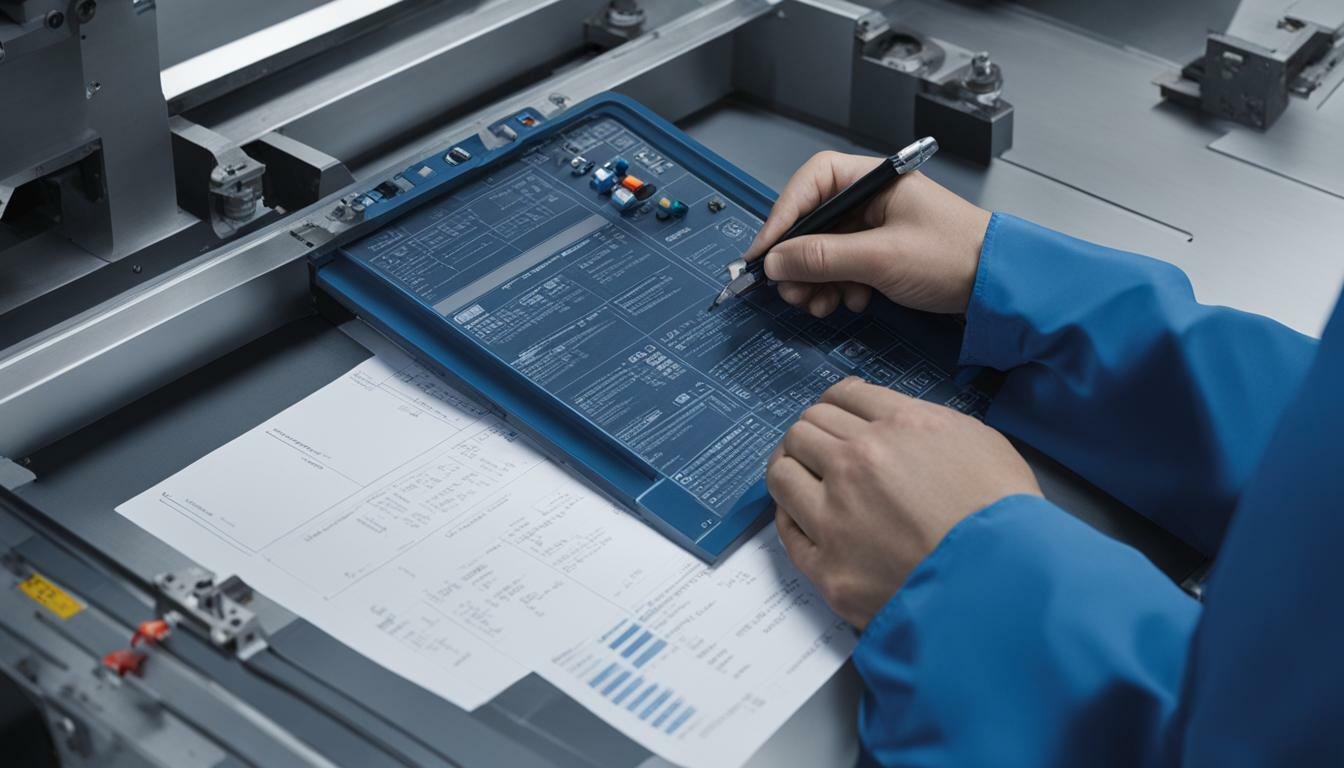Welcome to our comprehensive guide on the essential CNC machine inspection checklist, where we’ll cover everything you need to know to ensure optimum performance and maintain safety in your workshop. Regular maintenance of CNC machines is crucial for preventing unexpected downtime and maximizing productivity. By following this checklist, you will be able to identify potential issues early on and take necessary measures to keep your CNC machines running smoothly.
Proper inspection is essential for maintaining the performance and safety of your CNC machines. In this guide, we will provide detailed information on daily, weekly, monthly, and annual inspection tasks, as well as useful tips and best practices for effective machine maintenance.
Key Takeaways:
- Regular maintenance is vital for preventing downtime and ensuring optimal performance.
- Inspect pressure, lubricant levels, coolant, and air supply daily.
- Clean the machine and watch out for anomalies in operation.
- Perform weekly tasks such as cleaning the machine shop and checking for leakage.
- Monthly tasks include cleaning the chip collector and inspecting jaws and fixtures.
By following these inspection guidelines and conducting regular maintenance, you can extend the lifespan of your CNC machines, minimize downtime, and increase productivity. Stay tuned as we delve deeper into each inspection task in the upcoming sections of this comprehensive guide.
Why Regular CNC Machine Inspection is Important
Regular CNC machine inspection is essential to maintain the performance, accuracy, and longevity of your equipment. In this section, we’ll explore why inspection is important and provide you with best practices, steps, and tips for effective inspection.
Proper inspection plays a crucial role in identifying potential issues before they escalate into major problems. By conducting regular inspections, you can detect wear and tear, loose components, or alignment issues early on, allowing you to address them promptly and prevent costly downtime. A well-maintained CNC machine not only ensures consistent and precise output but also extends the lifespan of the equipment.
When it comes to CNC machine inspection, following best practices is key. This includes implementing a thorough checklist that covers all essential inspection tasks, from checking lubricant levels to inspecting machine components. Adhering to a comprehensive checklist ensures that no aspect of the machine is overlooked, minimizing the risk of malfunction and maximizing overall performance.
Steps for Effective CNC Machine Inspection
- Start with a visual inspection: Examine the machine for any signs of damage, loose wires, or irregularities in operation.
- Check lubricant levels: Proper lubrication is crucial for smooth machine operation. Ensure that the machine is adequately lubricated according to manufacturer recommendations.
- Inspect machine components: Pay close attention to crucial components such as spindles, bearings, belts, and tool holders. Look for signs of wear, damage, or misalignment.
- Test machine performance: Run sample programs to evaluate the machine’s accuracy, speed, and overall performance. Make necessary adjustments or repairs if any issues are identified.
By following these steps and incorporating regular CNC machine inspection into your maintenance routine, you can optimize the performance and longevity of your equipment, minimize downtime, and ensure the highest quality output.
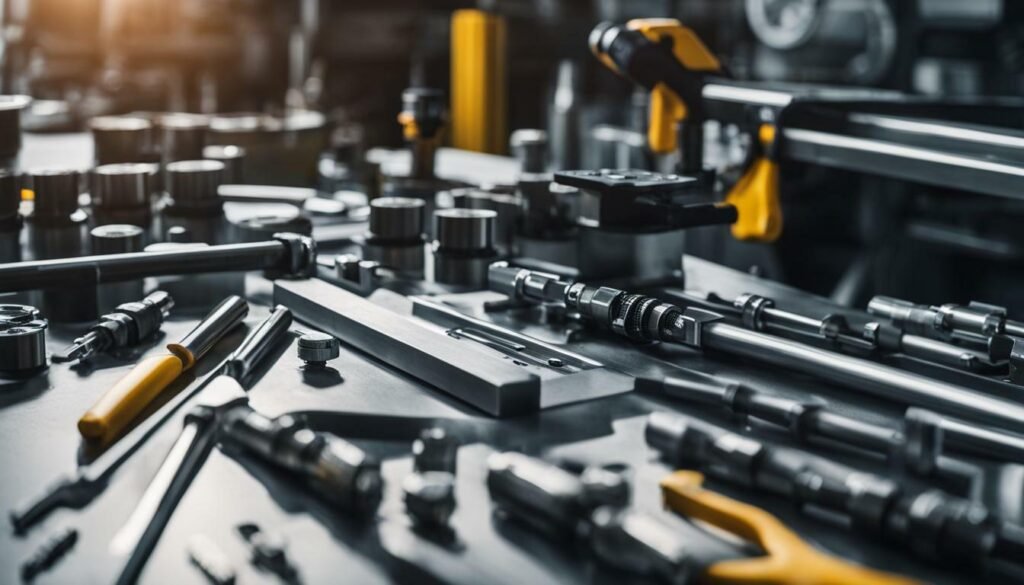
| Benefits of Regular CNC Machine Inspection | Best Practices |
|---|---|
| Identify potential issues before they escalate | Implement a thorough inspection checklist |
| Prevent costly downtime | Follow manufacturer recommendations for lubrication |
| Ensure consistent and precise output | Pay close attention to crucial machine components |
| Maximize equipment lifespan | Test machine performance regularly |
By incorporating regular CNC machine inspection into your maintenance routine and following best practices, you can ensure that your equipment operates at its best, delivering optimal performance and durability.
Daily CNC Machine Inspection Tasks
Performing daily inspections is crucial for identifying potential issues early on and preventing unexpected downtime. In this section, we’ll walk you through the daily checklist and preventive maintenance measures to keep your CNC machines in optimal condition.
Daily Inspection Checklist
Here is a checklist of the daily tasks that should be conducted to ensure the smooth operation of your CNC machines:
- Inspect the pressure and lubricant levels to ensure they are within the recommended range.
- Check the coolant and air supply to ensure they are functioning properly.
- Clean the machine, removing any debris or residue that may have accumulated.
- Watch out for any anomalies in machine operation, such as strange noises or vibrations, and take immediate action if needed.
By diligently following this checklist, you can catch potential issues early and address them before they escalate into major problems.
Preventive Maintenance Measures
In addition to the daily tasks, there are also preventive maintenance measures that should be undertaken to extend the lifespan of your CNC machines:
- Regularly inspect and clean the chip collector to prevent buildup and ensure proper chip evacuation.
- Inspect and adjust jaws and fixtures to ensure accurate and secure workpiece clamping.
- Clean and replace air filters as needed to maintain optimal air quality in the machine shop.
By incorporating these preventive measures into your daily inspections, you can minimize the risk of machine breakdowns and maximize productivity.

| Frequency | Tasks |
|---|---|
| Daily |
|
| Weekly |
|
| Monthly |
|
| Annual |
|
Weekly CNC Machine Inspection Tasks
Weekly inspections play a vital role in maintaining the overall health and performance of your CNC machines. In this section, we’ll guide you through the checklist for conducting weekly inspections and explain the significance of regular maintenance.
During your weekly inspection, it is important to focus on key areas that can impact the performance and longevity of your CNC machines. Here are some essential tasks to include in your checklist:
- Inspect and clean the coolant system to ensure proper cooling and lubrication. Check for any leaks or irregularities that may affect machine operation.
- Inspect the spindle, chuck, and tool holders for wear and damage. Ensure proper alignment and runout to maintain accuracy.
- Check and clean the way covers and ball screws to prevent debris buildup. Lubricate as necessary to ensure smooth movement.
- Inspect all safety features, such as emergency stops and interlocks, to ensure they are functioning properly for operator safety.
Regular maintenance and inspection of these key components will help identify any issues early on, allowing for prompt repairs and minimizing the risk of machine breakdowns.
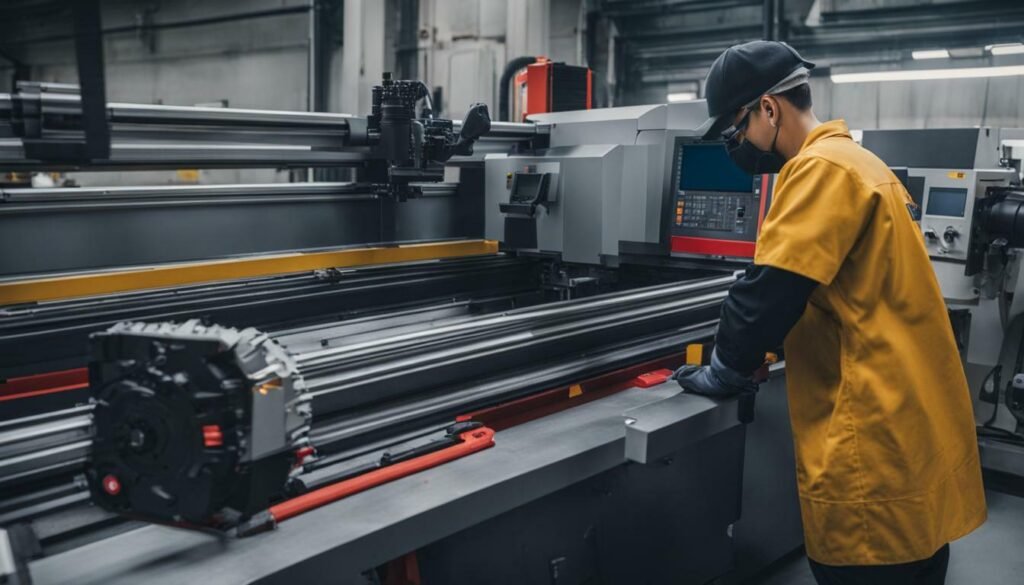
| Weekly CNC Machine Inspection Tasks | Actions |
|---|---|
| Inspect coolant system | Clean, check for leaks, and ensure proper functioning |
| Inspect spindle, chuck, and tool holders | Check for wear, damage, and proper alignment |
| Check way covers and ball screws | Clean and lubricate as necessary |
| Inspect safety features | Ensure proper functioning for operator safety |
By adhering to this weekly CNC machine inspection checklist, you can proactively address any potential issues and ensure the continued performance and longevity of your CNC machines.
Monthly CNC Machine Inspection Tasks
Monthly inspections help detect and address any underlying issues that may affect the performance of your CNC machines. In this section, we’ll delve into the checklist for monthly inspections and explore quality control and troubleshooting procedures.
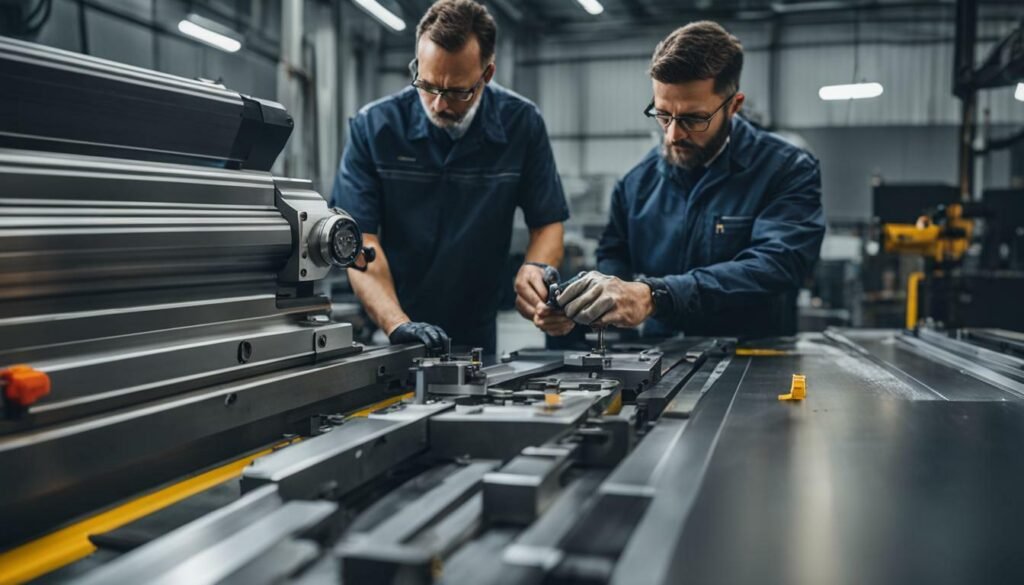
To ensure the smooth operation of your CNC machines, it is crucial to conduct thorough monthly inspections. This involves checking various components and systems to identify potential problems early on. Start by inspecting the machine’s structural integrity, including the frame, machine bed, and alignment. Look for any signs of wear or damage that could impact its performance.
Next, focus on the machine’s electrical system. Check all wiring connections, cables, and switches to ensure they are secure and functioning properly. Pay particular attention to the control panel and monitor for any error codes or abnormal behavior. This will help prevent potential malfunctions or breakdowns.
Furthermore, inspect the spindle and tooling system for any signs of wear or misalignment. Check the tool holders, collets, and tool turrets to ensure they are properly seated and tightened. Additionally, inspect the lubrication system and replenish the oil if necessary. Proper lubrication is crucial for reducing friction and prolonging the lifespan of machine components.
Lastly, perform a thorough cleaning of the machine’s chip collector, removing any debris or buildup that may obstruct the proper flow of coolant. Inspect and clean the air filters to maintain optimal air quality within the machine shop. By following a comprehensive monthly inspection checklist, you can identify potential issues early on and take the necessary steps to address them, ensuring the continued efficiency and reliability of your CNC machines.
Annual CNC Machine Inspection Tasks
Annual inspections are crucial for ensuring the long-term accuracy and reliability of your CNC machines. In this section, we’ll guide you through the checklist for annual inspections and highlight the significance of thorough maintenance and inspection.
During the annual inspection, it is important to check the alignment and runout of the spindle and chuck. Any misalignment can result in decreased precision and performance. Additionally, inspecting the tailstock and turret is essential to identify any wear or damage that may affect the machine’s functionality.
Another critical aspect of the annual inspection is checking for oil and air leakage. Leaks can lead to inefficient operation and potential damage to the machine. By identifying and addressing leaks promptly, you can prevent costly repairs and downtime.
| Annual CNC Machine Inspection Tasks | Timeframe | Actions |
|---|---|---|
| Spindle and Chuck Inspection | Annually | Check alignment and runout |
| Tailstock and Turret Inspection | Annually | Inspect for wear and damage |
| Oil and Air Leakage Check | Annually | Identify and address leaks |
By performing these tasks as part of the annual inspection, you can maintain the accuracy and reliability of your CNC machines, ensuring they continue to operate at their best. Following a comprehensive checklist like this is vital for avoiding unexpected downtime, reducing maintenance costs, and maximizing productivity.

Proper inspection and maintenance practices can significantly extend the lifespan of your CNC machines, maximizing your investment. In this section, we’ll share valuable tips, outline the inspection process, and emphasize the importance of adhering to industry standards.
Regular maintenance is crucial to prevent unexpected downtime and ensure optimal performance. By following a comprehensive inspection checklist, you can identify potential issues early on and address them promptly, minimizing costly repairs and production delays.
One important tip for CNC machine maintenance is to regularly clean and lubricate the machine. Dust, chips, and debris can accumulate over time and cause damage to sensitive components. By keeping the machine clean, you can prevent unnecessary wear and tear, ensuring smooth operation and prolonging the lifespan of the equipment.
Another key aspect of CNC machine inspection is to closely monitor and analyze the performance data. This includes tracking machine performance metrics, such as cutting speed, accuracy, and tool wear. By identifying any deviations from the expected performance, you can take corrective measures to maintain optimal machine functionality.
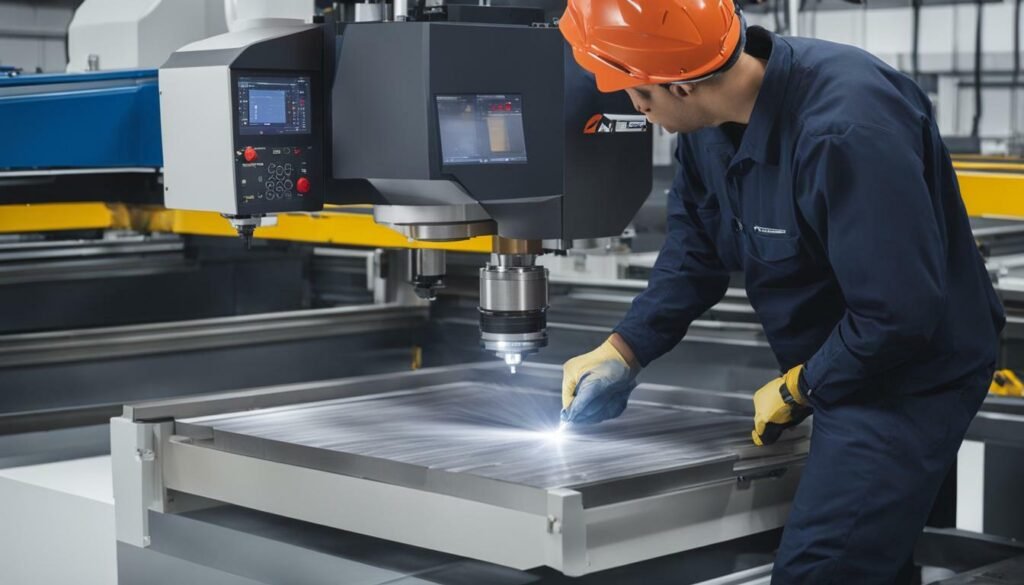
Adhering to industry standards and protocols is essential for effective CNC machine inspection. This ensures that the inspection process is carried out consistently and accurately, and that all safety measures are met. By following established guidelines and protocols, you can ensure the reliability, accuracy, and safety of your CNC machines.
By implementing regular inspection and maintenance practices, you can not only extend the lifespan of your CNC machines but also improve productivity and reduce operational costs. Preventive maintenance helps to identify and address potential issues before they escalate into major problems, allowing your machines to operate at their optimum level.
| Benefits of Regular CNC Machine Inspection |
|---|
| Minimizes downtime and production delays |
| Increases machine lifespan |
| Improves machine performance and accuracy |
| Reduces operational costs and repair expenses |
| Enhances workplace safety |
Machine Inspection Guidelines for Optimal Performance
Following proper machine inspection guidelines is pivotal to maintaining the optimal performance and efficiency of your CNC machines. In this section, we’ll provide you with best practices, inspection procedures, and highlight the importance of quality control and guideline adherence. To ensure your CNC machines are operating at their best, it is essential to establish a routine inspection schedule. Regularly inspecting critical components such as motors, belts, bearings, and tooling can help identify any issues before they lead to costly breakdowns or production delays. Adhering to a comprehensive checklist, as mentioned in the previous sections, will guide you through the necessary tasks for daily, weekly, monthly, and annual inspections. When conducting inspections, it is important to pay attention to detail. Thoroughly examine each component, checking for signs of wear, damage, or misalignment. Use precision measuring tools to verify dimensional accuracy and ensure proper alignment. In addition, don’t forget to inspect electrical connections, control panels, and safety features to ensure they are functioning correctly. Quality control plays a significant role in machine inspection. Implementing quality control measures such as statistical process control and regular calibration of measurement tools will help maintain the accuracy and reliability of your CNC machines. It is also crucial to document and track inspection results for future reference and analysis. By following proper machine inspection guidelines, you can minimize unplanned downtime, improve productivity, and extend the lifespan of your CNC machines. Remember, prevention is always better than cure, and investing time in routine inspections will undoubtedly yield long-term benefits for your business. 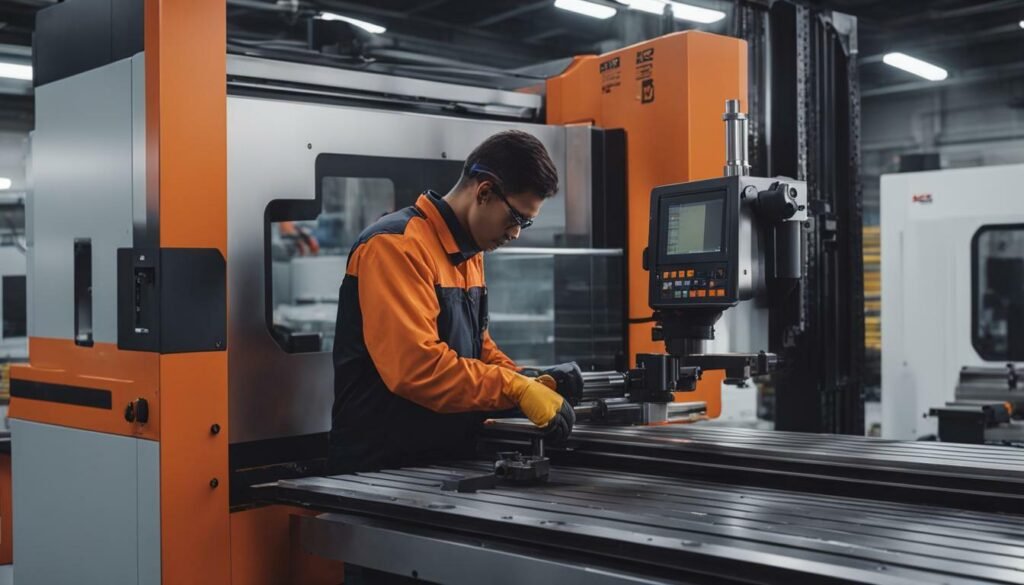
| Key Guidelines | Importance |
|---|---|
| Establish a routine inspection schedule | Prevents breakdowns and production delays |
| Thoroughly examine critical components | Identifies wear, damage, or misalignment |
| Verify dimensional accuracy and alignment | Maintains precision in machining processes |
| Inspect electrical connections and safety features | Ensures proper machine functionality |
| Implement quality control measures | Maintains accuracy and reliability |
| Document and track inspection results | Provides a reference for future analysis |
Following these machine inspection guidelines and implementing best practices will help you optimize the performance and productivity of your CNC machines. By adhering to a comprehensive inspection checklist, prioritizing quality control, and establishing a routine inspection schedule, you can minimize downtime, reduce maintenance costs, and ensure the longevity of your valuable CNC equipment.
Machine Inspection Techniques for Accuracy and Safety
Employing the right machine inspection techniques is crucial for maintaining accuracy and safety in your CNC operations. In this section, we’ll delve into various techniques, the use of inspection forms and checklists, and criteria to help you conduct effective machine inspections.
One effective technique for machine inspection is the visual inspection. This involves closely examining the machine for any signs of wear, damage, or abnormalities. Look for loose or damaged components, leaks, or excessive vibrations. Inspect the cutting tools for any signs of wear or breakage. It’s important to perform this inspection regularly to catch potential issues before they escalate.
Another technique is the use of inspection forms and checklists. These documents outline the specific areas and components that need to be inspected, ensuring that no step is overlooked. By following a checklist, you can systematically go through each inspection point, making sure that all necessary tasks are completed. Additionally, inspection forms provide a standardized way to document findings and record any necessary repairs or adjustments.
Criteria-based inspection is another valuable technique. This involves establishing specific criteria for each inspection point, such as tolerance limits or performance thresholds. By comparing the current state of the machine to these criteria, you can quickly identify any areas that require attention. This approach helps ensure that the machine is operating within acceptable parameters and maintains the desired level of accuracy and safety.
| Technique | Description |
|---|---|
| Visual Inspection | Closely examine the machine for wear, damage, and abnormalities |
| Inspection Forms and Checklists | Use standardized documents to ensure thorough inspections and systematic recording of findings |
| Criteria-based Inspection | Establish specific criteria to compare the machine’s current state and identify areas needing attention |
By employing these machine inspection techniques, you can enhance the accuracy and safety of your CNC operations. Regular inspections will help identify any potential issues or deviations from desired performance, allowing you to take proactive measures to address them. Remember to document your findings, perform necessary repairs or adjustments, and keep a record of all inspections to track the machine’s maintenance history. Following these best practices will result in improved productivity, extended machine lifespan, and reduced downtime.
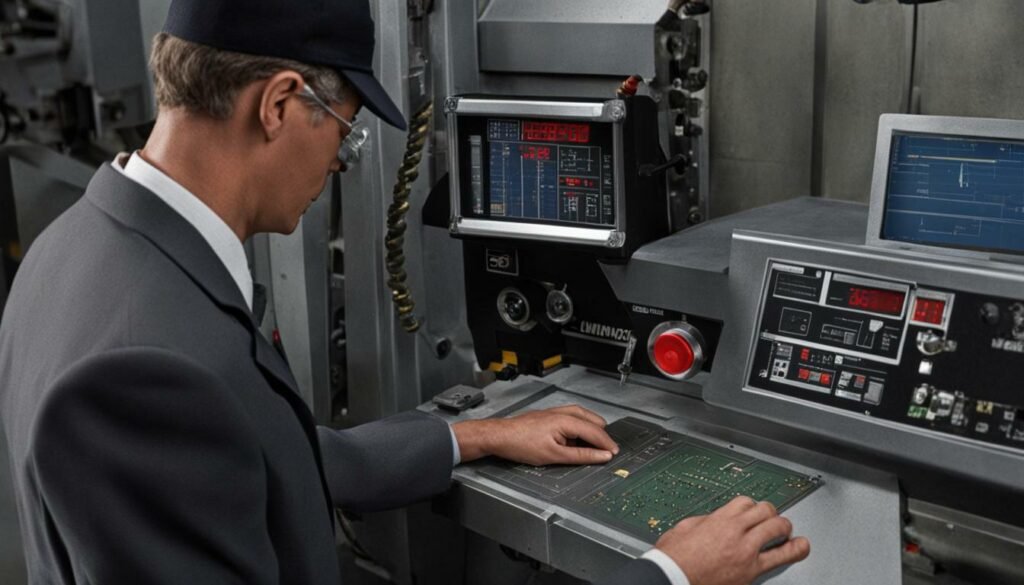
Note: The provided image represents a machine inspection in progress and is related to the topic of this section.
Conclusion
Regular CNC machine inspection and maintenance are vital for ensuring the continued performance, longevity, and safety of your equipment. By following the comprehensive inspection checklist provided in this guide, you can minimize downtime, increase productivity, and maximize the lifespan of your CNC machines.
Proper maintenance starts with daily tasks such as inspecting pressure and lubricant levels, checking coolant and air supply, and cleaning the machine. These routine checks help identify any anomalies in machine operation and prevent potential issues from escalating.
Weekly tasks involve cleaning the machine shop, checking for coolant and oil leakage, and inspecting machine components. By addressing any minor issues early on, you can avoid costly repairs and equipment downtime.
Monthly and annual tasks go beyond basic maintenance, focusing on more in-depth inspections and adjustments. These tasks include cleaning the chip collector, inspecting and adjusting jaws and fixtures, checking the spindle and chuck alignment, and inspecting the tailstock and turret. By performing these tasks regularly, you can ensure the accuracy and reliability of your CNC machines.
By adhering to this comprehensive inspection checklist, you can stay proactive in maintaining your CNC machines and prevent any unforeseen issues that may impact performance or safety. Remember, a well-maintained CNC machine is the key to maximizing productivity and minimizing downtime, ultimately leading to higher efficiency and profitability.
FAQ
Why is regular CNC machine inspection important?
Regular CNC machine inspection is important to prevent unexpected downtime and ensure optimal performance. It helps to identify and address potential issues early on, minimizing the risk of costly breakdowns and increasing productivity.
What are the daily CNC machine inspection tasks?
Daily CNC machine inspection tasks include inspecting pressure and lubricant levels, checking coolant and air supply, cleaning the machine, and monitoring machine operation for any anomalies.
What are the weekly CNC machine inspection tasks?
Weekly CNC machine inspection tasks include cleaning the machine shop, checking for coolant and oil leakage, and inspecting machine components to ensure they are in good condition.
What are the monthly CNC machine inspection tasks?
Monthly CNC machine inspection tasks involve cleaning the chip collector, inspecting and adjusting jaws and fixtures, and cleaning air filters to maintain optimal performance.
What are the annual CNC machine inspection tasks?
Annual CNC machine inspection tasks include checking the spindle and chuck for alignment and runout issues, inspecting the tailstock and turret, and checking for oil and air leakage to ensure accuracy and reliability.
How can following this comprehensive inspection checklist extend the lifespan of CNC machines?
Following this comprehensive inspection checklist helps identify and address issues early on, preventing costly breakdowns and extending the lifespan of CNC machines. It also ensures optimal performance and increases productivity.
What Are the Pros and Cons of CNC Milling Compared to Traditional Machine Inspection?
When comparing CNC milling and traditional machine inspection, it is vital to consider the pros and cons. One advantage of CNC milling is automation, providing increased accuracy and efficiency. However, traditional machine inspection offers a tactile approach that allows for immediate adjustments. In summary, an insightful analysis of cnc milling reveals both its advantages and limitations compared to traditional methods of machine inspection.
